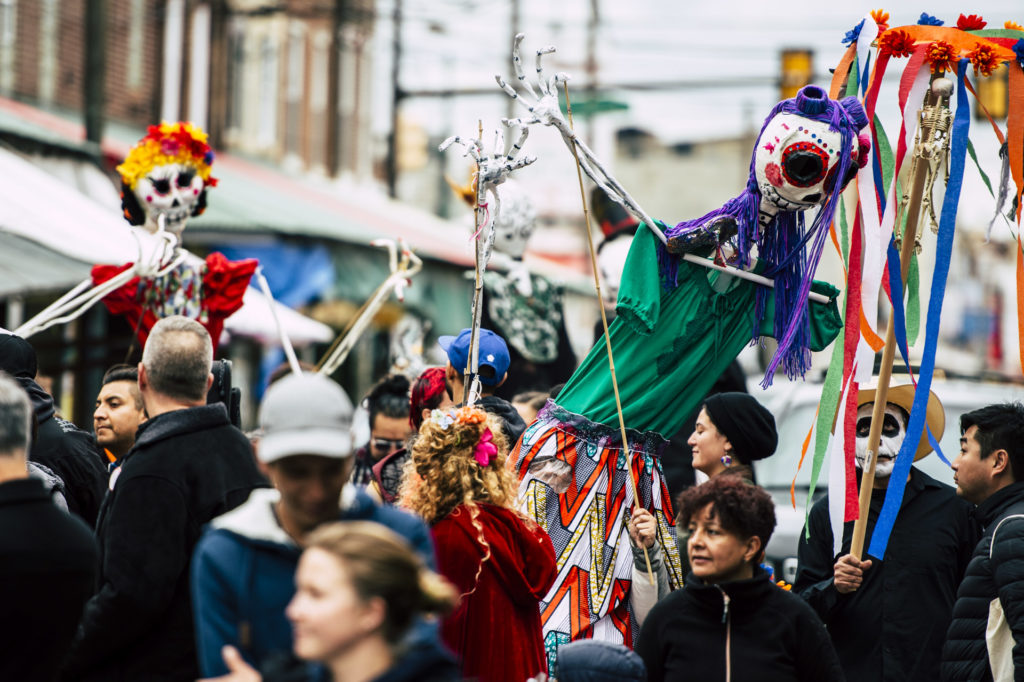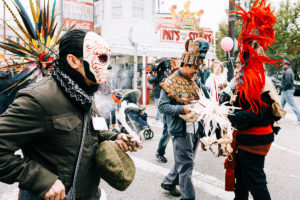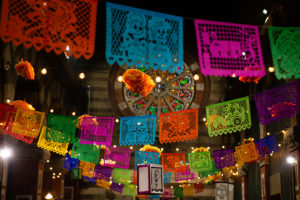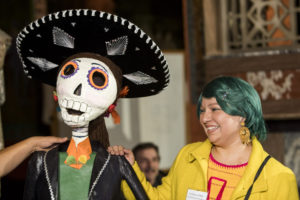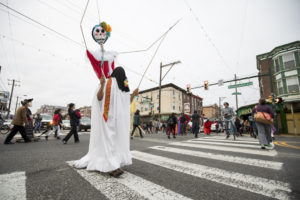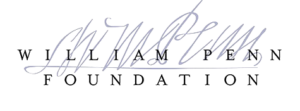Join the Celebration!
Day of the Dead is celebrated in Mexico and Central America on November 2nd. This year, the stars and the calendar aligned for us and we will be celebrating on that same day, the actual Day of the Dead. This is our 12th year of celebrating at Fleisher Art Memorial with our dear, growing community and we continue to explore the many different elements of this beautiful tradition in our very own special Philly way.
DAY OF THE DEAD ITINERARY
2:00 pm Children’s Fair in Fleisher’s parking lot
2:00 pm La Calaca Market with artisanal crafts from Latin America
4:00 pm Procession gathering outside the doors of the Sanctuary at Fleisher Art Memorial to follow the Champion Lowriders with La Calacleta.
5:30 pm Dancers from Canpatlaneci Danza Azteca del Anahuac initiate the evening celebrations in Fleisher’s parking lot
6-9 pm Entertainment by Los Guachinangos, Son Revoltura, Los Bomberos de la Calle, Children’s Mexican Folkloric Dance Group Ñuuxakun, Los Guachinangitos and much more.
FOOD TRUCK: El Charro Negro and Peruvian Family Food Truck
The Fauna of the Day of the Dead | La Ofrenda 2024
Our lead artist for 2024, Joaquina Cuba, has been a constant participant in the celebrations of this tradition. This year, Joaquina wants to explore elements of the Day of the Dead that have significance in both the ancient world, through Aztec and Mayan legends, as well as the current world by focusing attention on the fauna that surrounds this tradition. Her love for animals inspires this year’s theme and while there are many animals with important significance in both La Ofrenda (the altar), and the overall celebrations of this tradition, we will be focusing our attention to four distinctive animals that are either spiritual guardians, messengers or gods: the hummingbird, the monarch butterfly, the Xolo dog (a.k.a. the Mexican hairless dog) and the ajolote (a.k.a. the Mexican walking fish).
La Ofrenda represents and honors the people we lost that were close to us. In Mexico and other Latin American countries that celebrate this tradition, the altars are assembled in the family home to create a pleasant and familiar space to which the souls of the dead can return and feel welcomed. This tradition continues to evolve as celebrants continue to migrate, finding new ways to honor our dear departed away from their homelands. A Day of the Dead for pets is now celebrated (October 27) and while many suggest that this is a fairly new tradition, it is important to recognize that animals played an important role in pre-Columbian civilization, sometimes worshiped, sacrificed as offerings to the Gods or simply as companions. These days, our pets are our family and the need to include them and remember them on the Day of the Dead Ofrenda is quite logical.
Significance of selected Ofrenda Pets:
Mariposas Monarca, the Monarch Butterfly
Simply by looking at them, you get the feeling that Fall is in the air. They travel over 2,500 miles from Canada and the United States to arrive in the forests of Mexico just in time for the Day of the Death celebrations. Their orange color, similar to the official Day of the Dead flower, Cempasuchil or marigold, reminds us of the season. Their determination to migrate reminds us of our own life journeys. It is believed that they are the souls of our departed loved ones coming back to visit us one more time. These incredible insects are endangered due to deforestation and the use of pesticides and with our Day of the Dead, we celebrate them and seek to raise awareness of their dwindling numbers.
Colibri, the Hummingbird
This beautiful and elegant bird is considered a messenger between the worlds of the living and the dead. If you are lucky to encounter one, it means that a beloved departed soul wants to communicate with you or simply be near you. It could also mean that they want to guide you or give you some good news. Legend has it that our dear departed never really leave us and instead, they find messengers to come and pay us a visit and keep us company. And that’s exactly what these creatures are considered, a messenger with good intentions between both worlds.
Atlxólotl o Ajolote, the Mexican Walking Fish
This cute native amphibian from the Mexican Valley lakes might be small in size but is large in significance. In Mexican mythology, the name Atlxólotl means water monster or water dog and it was sometimes considered to be the aquatic divination of Xolotl, the twin brother of Quetzalcoatl, one of the major deities of the Mesoamerican era. While there are many versions of who Xolotl was as a God, including the god of lightning, fire, and death, his power for dualities is always present. One myth has him escaping being sacrificed by becoming an ajolote, an amphibious being that can live between the earth and the water. He is also known as God of the Dead, guiding the departed to Mictlan, the afterlife.
Xoloitzcuintli, the Mexican hairless dog
This legendary dog is as ancient as the Aztec pyramids and a crucial part of the Mexican heritage and of any Ofrenda. They are Mexico’s national dog and since 2020 they are also a symbol of Mexico City. Not only are they ideal dogs because of their devotion and intelligence but they are, after all, the dog of the Gods. Their name comes from Xolotl which is one of the most powerful Aztec gods. These wonderful pets are considered spiritual guardians and protectors whether by warding off evil forces, guarding our families from evil spirits, or guiding our dear departed through the afterlife.
We invite you to join us Friday, November 1 to help us construct La Ofrenda in the Sanctuary space at Fleisher Art Memorial. And on Saturday, November 2, our Ofrenda will be open to the public after the Day of the Dead procession through the streets of South Philadelphia.
La Ofrenda will be on display in our Sanctuary space the week of November 4, with the exception of Tuesday, November 5, election day. Please call our front desk for visitor hours: 215-922-3456.
For more information about this event, please contact Gerard Silva, Director of Community Outreach at gsilva@fleisher.org.
Closing Event | Saturday, November 9
6:00 pm at Fleisher Art Memorial – Free film screening by the Cineclub El Conejo del Faro: El esqueleto de la señora Morales (Rogelio A. González, 1959)
ITINERARIO DEL DÍA DE LOS MUERTOS
2:00 pm: Talleres infantiles de arte del Día de los Muertos con actividades creativas para educar acerca de esta tradición y celebrar con nuestros niños.
2:00 pm: El Mercado de las Calacas con las artesanías de nuestra gente en el estacionamiento de Fleisher hasta las 9:00 pm.
4:00 pm: Punto de encuentro para todos los participantes en la procesión será al frente del Santuario de Fleisher, 719 Calle Catharine. Los Champion Lowriders lideran la procesión con La Calacleta.
4:30 pm: Partida de la procesión a través de la Calle 8 hasta la Calle Federal y de regreso a través de la Calle 9. ¡Únanse!
5:30 pm: Canpatlaneci Danza Azteca Del Anahuac inauguran y bendicen las celebraciones al regreso de la procesión en el estacionamiento de Fleisher.
6-9 pm: Entretenimiento de música y danza con Los Guachinangos, Son Revoltura, Los Bomberos de la Calle, el baile folclórico infantil Ñuuxakun, Los Guachinangitos y mucho más.
Camión de Comida Mexicana: El Charro Negro y el Peruvian Family Food Truck
EVENTO DE CLAUSURA | Sábado, 9 de noviembre
6:00 pm en Fleisher Art Memorial – Cineclub El Conejo del Faro presenta: El esqueleto de la señora Morales (Rogelio A. González, 1959)
About the Artist
Joaquina Cuba
Joaquina Cuba is from Santa Maria Atexcac in Puebla, Mexico. Born to a large patriarchal family, Joaquina struggled to be seen as she dreamed of a creative future for herself. At only 10 years of age, she learned to make crafts and sell them thanks to the encouragement of her aunt and an instructor. The odds of making a living were not favorable for women in the Mexico she grew up in, so Joaquina made the hard decision to move to the states at age 15 looking for better opportunities for herself and her family. Uncertain of her future, with no knowledge of the English language, and hesitant to speak Spanish in the new city, Joaquina overcame her anxiety and depression in order to survive, and art played an important role in her new journey.
As an immigrant in Philadelphia, Joaquina was presented with many new challenges that still exist in our city: lack of basic resources, lack of health services and no opportunity to get an education. But Joaquina was determined to have the creative career she desired. She sought community spaces in which she could grow and thrive. First, she joined the group Valientes Guerreras by WOAR, a women’s group designed to empower through art therapy. Quickly, she went from student to instructor there, giving her the confidence necessary to pursue her goals as an artist. She has led many workshops for various Philadelphia organizations such as Puentes de Salud, Vamos Juntos and Fleisher Art Memorial and social justice remains at the forefront of all of her work. She has been an active participant and contributor to the Day of the Dead celebrations, leading workshops and creating elaborate sculptures. We are excited for her to be the artist chosen this year by the La Calaca Flaca committee to bring her vision to La Ofrenda (the altar) and designate a theme for the celebrations of the Day of the Dead. Her theme: The Fauna of the Day of the Dead.
Joaquina is more than a survivor: she is a warrior, one that knows that giving up is never an option whether in her personal life or in her artistic journey. Through art she feels empowered, and this strength allows her to continue creating and inspiring others to do the same. ¡Que viva el arte!


